Historyland Nursery
Wholesale Quality Container Grown Ornamental Shrubs
Fruit
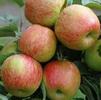
Malus domestica 'Braeburn'
Common Name: Braeburn Apple
A semi-dwarf variety, the Braeburn is fairly easy to grow and produces heavily at a young age. This apple is firm to the touch with red-orange vertical stripes against a yellow-green body. Best eaten slightly cooled to bring out the sharp refreshing flavor that has a good balance of tartness and sweetness. Good cooking apple as it holds it shape, also producing a lot of liquid making it ideal for tarts. Stores well when kept chilled. Pollinates with Fugi. We offer Braeburn 1"+ caliper plus in a 15 gallon container.
[More Info]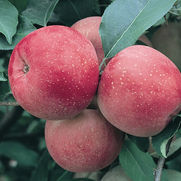
Malus domestica 'Fuji'
Common Name: Fuji Apple
White buds open to white flowers in mid April followed by medium sized reddish-green fruit in late September and October. Crunchy and full of flavor, the Fuji has become one of American's favorite eating apples since it was introduced in the 1960s. Pollinates well with Granny Smith or Yellow Delicious.
We offer Fuji 1"+ caliper in a 15 gallon container.
[More Info]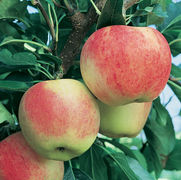
Malus domestica 'Gala'
Common Name: Gala Apple
Light pink buds open to pink and white blooms in April. Beginning in August nice crisp, firm and sweet fruit begin to ripen and continues through the fall. One of the country’s most popular apples. Fruit can be stored for up to 6 months. Very adaptable and easy to grow, maintains its oval shape as it matures. A very reliable pollinizer for other apples blooming at the same time. Pollinates with Yellow Delicious.
We offer Gala 1"+ caliper in a 15 gallon container.
[More Info]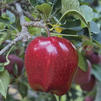
Malus domestica 'Red Delicious'
Common Name: Red Delicious Apple
Pink blooms fade to white on Americans favorite snacking apple in late spring. Beginning in September and into October the red crisp, fine textured mildly sweet fruit begin to ripen. Adapts to many soil conditions, this is an easy tree to grow. Pollinates with Cortland, Granny Smith or Yellow Delicious.
We offer Red Delicious 1"+ caliper in a 15 gallon container.
[More Info]
Malus domestica 'Winesap' ''
Common Name: Winesap Apple
The Winesap is an old semi-dwarf apple variety. They are good for eating, juicing, and baking. It has a crisp,
yellowish flesh cover with a deep red skin. It is a good all purpose apple and has great keeping qualities.
We offer Winesap 1" caliper plus in a 15 gallon container.
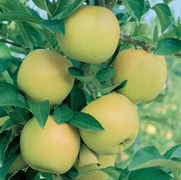
Malus domestica 'Yellow Delicious'
Common Name: Yellow Delicious Apple
Pink buds open to white flowers in the spring and by September and October the golden yellow skin fruit begins to ripen. Sweet, full of flavor eaten fresh and in desserts. Excellent pollinator for other apples trees blooming at the same time.
We offer Yellow Delicious 1"+ caliper in a 15 gallon container.
[More Info]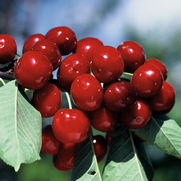
Prunus avium 'Bing'
Common Name: Bing Cherry
The most popular of all the sweet cherries. Large dark red heart-shaped fruit that is firm, sweet and very jucy. Begin enjoying its fruit in early July. Pollinate with Black Tartarian.
We offer Bing 1"+ caliper in a 15 gallon container.
[More Info]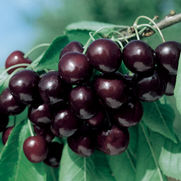
Prunus avium 'Black Tartarian'
Common Name: Black Tartarian Cherry
This semi-dwarf tree has very dark purplish-red medium sized fruit that ripens early in the season. The flesh of the fruit is tender, very juicy and sweet. Pollinates with Lapins or Bing.
We offer Black Tartarian 1"+ caliper in a 15 gallon container.
[More Info]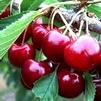
Prunus avium 'Lapins'
Common Name: Lapins Cherry
A semi-dwarf variety that produces huge, juicy fruit in mid to late July. One cherry is a mouthful! Firm cherries resist splitting. Self-fertile. Use as a pollinator for other varieties.
[More Info]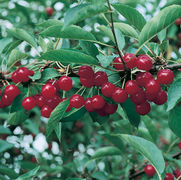
Prunus cerasus 'Montmorency'
Common Name: Montmorency Cherry
The most popular cherry for making cherry pies. Blooms in early May and ripens in early July with an abundant bounty of fruit. Full sun, adapts to a variety of soil types. The tree is self-fertile and produces large sized, dark red cherries with a good tangy flavor.
We offer Montmorency 1"+ caliper in a 15 gallon container.
[More Info]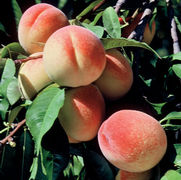
Prunus persica 'Elberta'
Common Name: Elberta peach
This dwarf peach is the most disease resistant peach tree available. Beautiful rose-red blooms in spring with large yellow fruit in mid-August. Eaten fresh but best known for canning. Full to partial sun, widely adaptable to different soil types. Self-pollinating.
We offer Elberta 1"+ caliper in a 15 gallon container.
[More Info]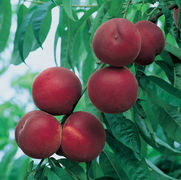
Prunus persica 'Suncrest'
Common Name: Suncrest peach
The fruit of this peach is large, round, firm and very sweet and tasty. Harvest in mid-season, self-pollinating tree. Grows well in full sun and adapts to most soil types.
We offer Suncrest 1"+ caliper in a 15 gallon container.
[More Info]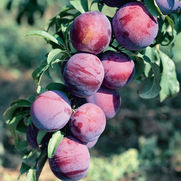
Prunus salicina 'Burbank'
Common Name: Burbank Plum
A semi-dwarf variety with a flat topped habit that produces an abundance of sweet and juicy fruit suitable for canning, baking, desserts or eating fresh. Will pollinate with Satsuma plum.
We offer Burbank 1"+ caliper in a 15 gallon container.
[More Info]
Pyrus communis 'Bosc'
Common Name: Bosc pear
This large, upright tree blooms late, giving way to dark yellow and russet skinned fruits. Sweet, tender, juicy fruits have a slight acidic flavor excellent for eating fresh or baking. Very reliable producer.
[More Info]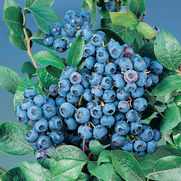
Vaccinium corymbosum 'Bluecrop'
Common Name: Blueberry
This vigorous grower, brings forth perfectly white bell shaped flowers in the spring. Abundant large light blue, sweet and firm fruit in mid July to early August. This is the leading commercial blueberry variety in North America. Good eaten fresh, cooking, jellies and jams and freezing. More drought resistant and cold-hardy than most other varieties. Dark green leaves turn a bright red in the fall followed by bright red stems in the winter.
We offer Bluecrop 24"+ in a 5 gallon container.
[More Info]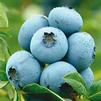
Vaccinium corymbosum 'Northland'
Common Name: Blueberry
Blueberries have amazing health benefits. Packed with vitamins A and C, potassium, phosphorus, and just 80 calories with 4 grams of fiber per cup. This is the perfect snack. This deciduous shrub has waxy, white, bell-shaped spring flowers, ripe fruit in June, and orange fall color.
We offer Northland 24" plus in a 5 gallon container.
[More Info]
Vaccinium x 'Chandler'
Common Name: Blueberry
The Chandler ripens mid-July to late August and continues for up to six weeks providing an abundance of large delicious flavored fruit. Good eaten fresh but is mainly used for cooking and freezing. The bush is vigorous with large, dark green foliage and a slightly spreading habit. Fall color is orange-red with red winter stems.
We offer Chandler 24"+ in a 5 gallon container.
[More Info]